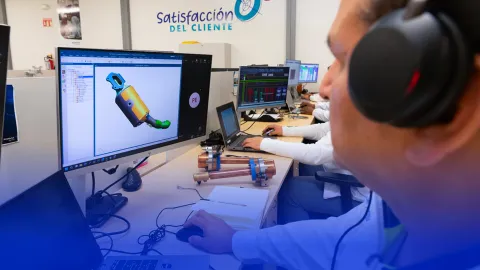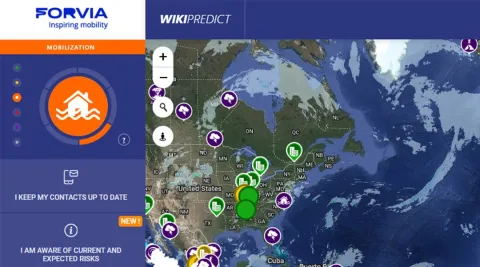Waves of Innovation: Building a Resilient FORVIA

From heavy rain collapsing a warehouse roof in Germany to wildfires threatening plants in Portugal, extreme weather has already tested the strength of our operations. FORVIA is working to ensure that our people, assets, and operations can withstand the shocks of an unpredictable climate and, in doing so, turn risk into resilience.
Balancing Mitigation and Adaptation
Our climate strategy is built around two connected pillars. Mitigation reduces greenhouse gas emissions to limit the pace of climate change. Adaptation prepares the company to operate through the physical impacts of climate change.
The two work in tandem: slowing the problem while strengthening the ability to withstand it. This matters because the threats are both sudden and slow-moving. A flood, storm or cyclone can shut down a site in hours, while gradual shifts, such as hotter summers, prolonged droughts and dwindling water supplies, can erode operations over years.
And the risks are set to grow. By 2050, as per the SwissRe exposure dataset (which considers worst-case scenarios) of the Intergovernmental Panel on Climate Change (IPCC), 10% of our plants could face extreme heatwaves, close to 40% could be located in regions facing intense and prolonged rainfall and 16% could be in zones at risk of extreme drought.
Data into Action
With climate-driven natural disasters on the rise, adaptation is now part of FORVIA’s daily operations. Every site has a hazard profile in the FORVIA real estate database, built using climate models based on the IPCC scenarios. These models project how local hazards such as extreme heat, heavy rainfall, drought, or cyclones could intensify by 2030 and 2050 under different global warming scenarios. This information shapes decisions on new projects, acquisitions and leases, ensuring resilience is factored in from the outset.
Best Practices for Global Adaptation
FORVIA shapes its climate adaptation practices by combining local know-how with company-wide integration. Pilot projects, designed with the OCARA methodology (a method and tool to diagnose climate resilience) and supported by Carbone 4 (a firm specializing in energy transition), feed into a shared catalogue of adaptation measures so that proven solutions can be replicated across regions.
To identify where action is most urgent, natural hazard risks are assessed with the support of our insurer, helping to set priorities for risk management and investment. Oversight of these practices sits with the insurance department, led by Group Property Loss Control Manager Elodie Dunand. Progress is reviewed every six months by the Group Risk Committee and discussed monthly within each business group’s footprint committee.
The active involvement of the CFO ensures climate risk is integrated into both financial and operational decision-making, keeping adaptation anchored in the company’s overall strategy.
The proactive steps taken in different parts of the world reflect these best practices in action. In China, roofs are reinforced to withstand the winds of typhoon season. Across Southeast Asia, thermal comfort assessments guide interior changes so employees can work in more comfortable conditions during heatwaves. Vegetation is planted around facilities to create cooler microclimates, roofs are coated with high reflective white paint, etc., to reduce heat exposure. In Europe, flood-prone sites are securing buildings with flood barriers and improving roof drainage systems to withstand stronger winter storms. In regions under severe water stress, like Mexico, plants are mapping the processes most dependent on water and adapting infrastructure to reduce demand.
Each structural, operational, or environmental measure is reviewed to avoid maladaptation and align with our CO2 objectives and biodiversity strategy. Climate readiness is integrated into design choices and daily routines, creating an organization prepared to meet the future with the confidence that comes from preparation. This care and resolve is yet another example of how we continue to carry forward the currents of the Blue Effect, where every one of our actions strengthens and creates lasting, positive change.




